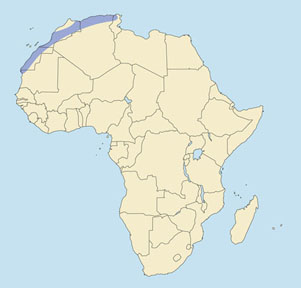 |
Gazella cuvieri
Gacela del Atlas (Sp), Edmi-Gazelle (G), Edmi, Gazelle de Cuvier (F). Also called Cuvier gazelle, or edmi (Arabic), or edem (Tunisia). Named for French anatomist and paleontologist Baron Georges L. Cuvier (1769-1832), whom many considered the foremost naturalist of his time. It should be noted that the name edmi or idmi is also applied by local people in Arabia and the Middle East to the mountain gazelle (Gazella gazella) of that region.
DESCRIPTION Shoulder height 26-28 inches (66-71 cm). Weight 50-60 pounds (23-27 kg).
A smaller gazelle, with a rough, thick grayish brown coat, a dark flank band, dark pygal (rump) stripes, white underparts, a dark brown facial blaze, a whitish stripe above the eye, a dark brown stripe from corner of eye to muzzle, and a dark spot on the nose. Knee tufts are present. Tail has a black tip. Horns (both sexes) are comparatively thick at the base and strongly ringed. They are rather upright and parallel, with a small upward and forward bend at the tips. Good horns are 11 inches (28 cm) or more. Longest of record are 15 inches (38 cm). Females are similar to males, but smaller, and have smaller, smoother, straighter horns.
BEHAVIOR Lives in pairs or family groups. Births occur in April-May after about six months gestation, normally with a single young, sometimes twins. Lifespan as much as 12 years.
Both a grazer and a browser. Drinks water where available, otherwise obtains moisture from dew and food. Eyesight, hearing and sense of smell are good. Said to be as good a cragsman as a chamois.
HABITAT Mountains to 7,000 feet (2,100 m), primarily intermountain basins and forests, but also cliff areas.
DISTRIBUTION Mountains in Morocco, Algeria and Tunisia; specifically the Atlas and Anti Atlas mountains, the Bani Hills, and the high plateaus between the Tellien and Saharan Atlas.
TAXONOMIC NOTES Some zoologists classify this animal as a subspecies of mountain gazelle (Gazella gazella) of the Middle East. Others regard it as conspecific with the red-fronted gazelle (G. rufifrons) or the Thomson gazelle (G. thomsoni). We follow Gentry in treating it as a full species. No subspecies are recognized.
STATUS Listed as endangered by the IUCN and the USF&WS (1970).
|





